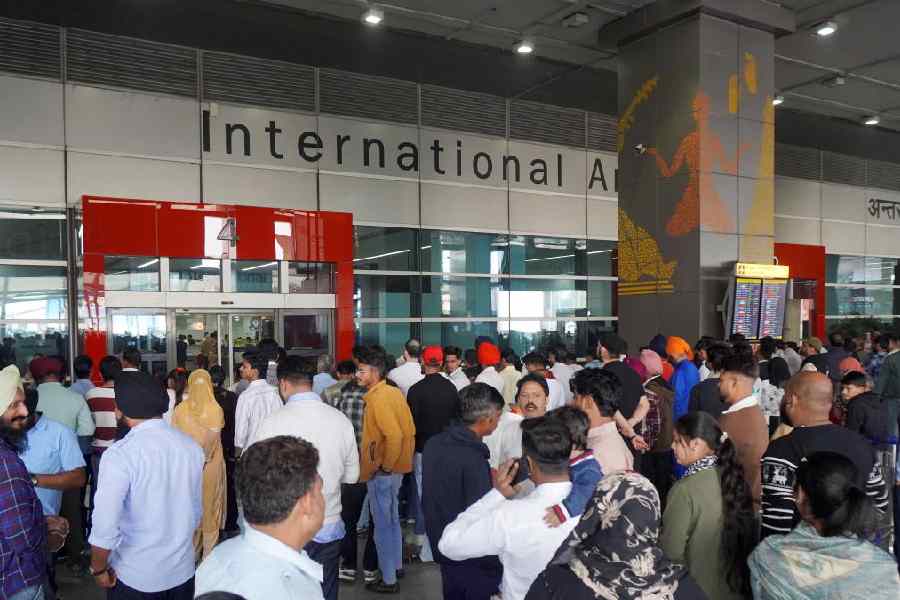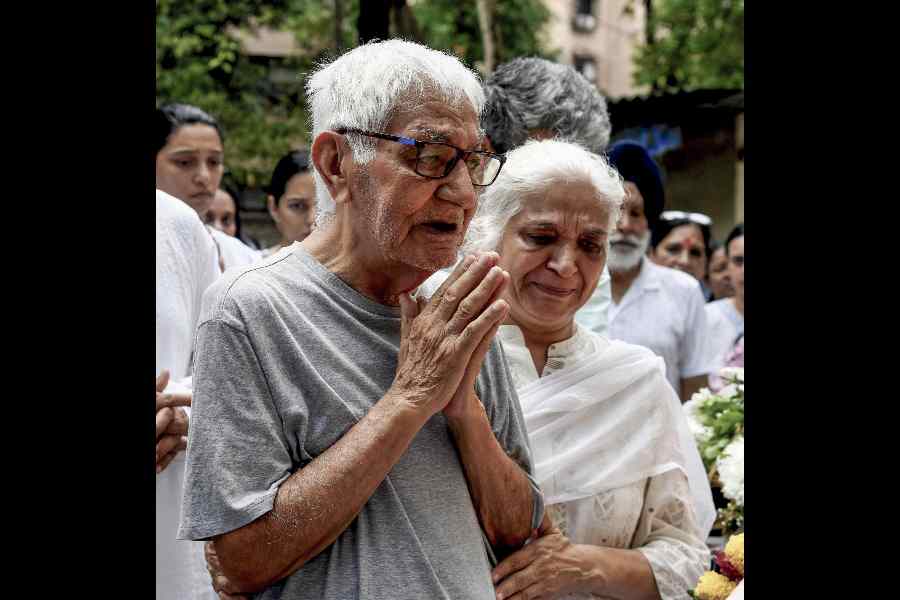 |
| Vijay Manzil, the estate of the maharaja of Burdwan |
It would not be far-fetched to say that the Aldabra giant tortoise is the oldest living resident of Alipore. After spending 125 years at the Barrackpore zoo it was brought to the zoological gardens in 1875, and has lived there since. Such an accretion of years in any living being leaves us with a sense of awe and wonder.
We are similarly wonder-struck when we come face to face with a human being of prodigious age. For we confront, as it were, the march of time in person. Such a one is Renuka Roychoudhury, mejobou, or wife of Rabindranath, second of the three sons of the Maharaja of Santosh, Manmatha Nath Roychoudhury. It is amazing how lightly she bears the burden of years. She has a clear memory, and still crochets dexterously with tapering fingers. Her father was from Narail but she was born in north Calcutta in 1912.
She was married in 1925, but her family left the house at 21 (now 21C, home of the German consul) Raja Santosh Road in 1985, and now lives in a flat with her daughter-in-law, impresario and theatre person Renu Roy in Alipore Avenue, lined with highrises. The Roy house is one of the last in this hinterland of Alipore, once a den of wagon-breakers.
Boat Canal used to flow beyond the trees and heavy shrubbery, but it started drying up in the early 1960?s. Now it is a dusty trough interspersed with hyacinth-filled bogs.
Earlier, I had met Indrani Ghosh, daughter of Raja Binayendranath, eldest son of Santosh maharaja at her Lansdowne Road home. She said both her mother and aunt Renukadebi were married on the same day at a very early age, and though they lived in a joint family they always had a good time together.
Renukadebi, who has written many a book in her time, says the family first resided at 3 Alipore Road, where the Bajorias live today. 21 Santosh Road was bought from a sahib and a tower clock was constructed in 1912. ?The lifestyle was very regal. The sentry stood guard round the clock. A bell would ring once whenever anybody passed by. Twice when anybody came home. Riding was their favourite pastime,? she said.
The viceroy would visit the house twice a year, when lavish parties were thrown. But the maharani was always in purdah, and the English ladies would go inside to meet her. All the food and drinks were home made. ?Yet the maharani would herself cook for the maharaja. He preferred her touch. No alcohol was ever served. The maharaja, a teetotaller, wouldn?t even touch tonics. Then came the sunset law and the family fell on hard times. The maharaja died around 1935-36. Later we were compelled to leave the house,? says Renukadebi.
Alipore was the playground of royalty. As Karuna Devi of Burdwan had said, all aristocratic families lived in Alipore ? the seat of the government at Belvedere ? to enable them to receive the Raj dignitaries. Burdwan, Cooch Behar, Santosh in Tangail and Mayurbhanj coexisted.
All that remains of Woodlands is its name. The eponymous nursing home came up in the 1960s. Maharaja Nipendra Narayan Bhup Bahadur of Cooch Behar, grandfather of the Rajmata of Jaipur, Gayatri Devi, had bought the 100-acre Woodlands in the latter part of the 19th century. Gayatri Debi, who has written her memoirs, faxed these nuggets of information to her nephew Bharat Dev Varma on the neighbourhood where the Birlas live now. Bharat?s maternal uncle was Maharaja Jagdipendra Narayan of Cooch Behar, popularly known as Bhaya or Coochie.
?The area of the estate was very big as it included a cricket ground, a huge lawn and two tennis courts, stables for about 30 horses and a nursery for plants and a garage for up to 20 cars. During the war, Maharaja Jagdipendra Narayan of Cooch Behar gave it to the Bengal Government to be used as a hospital and he himself moved into the staff quarters. Cricket matches were regularly held at Woodlands. The MCC also played here.?
Bharat Dev Varma, who lived in the annexe as a child in the 1940s and whose elder brother Bheem and sister Devika were born in the main mansion in 1937 and 1938, respectively, came up with more details: ?The main house was demolished in 1949. There used to be a dhobi talao in the compound which was still wooded. There were few buildings there. The only others were the Viceregal lodge, now the National Library, the Burdwan estate and Mayurbhanj house, which had no estate. Often, particularly during winter, when the whole of undivided India descended on Calcutta for polo, cricket, Christmas and new year, Woodlands hosted the most elegant parties spread over the gardens and lawns.?
Vijay Manzil ? or what is left of it ? is screened by the apartment blocks of Diamond Harbour Road. But the two gateways of the Burdwan maharaja?s mansion still stand ? the solitary one on Judge?s Court Road looking miserable in the midst of nowhere, and the whitewashed portal on Diamond Harbour Road ?indicating the hugeness of the estate covering 78 bighas.
 |
| Renuka Roychoudhury |
Karuna Devi, whose great grandfather Maharaja Aftab Chandra Mahtab had acquired the estate from the Aratoons in the late 19th century, says there was not a single house in sight apart from the staff quarters, and recently, her youngest uncle knocked down a beautiful house next door. At the furthest end of Alipore was Portland Park. There were indoor tennis courts and three ponds. Now only one exists, towering above which is mammoth apartment block wearing a fake Victoria House dome to cap it all.
From its Burdwan Road gateway, the mansion with a turret and pedimented entrance could be out of a fairytale smothered though the skyline is with highrises. Though Sir Anthony Hayward, last British burrasaab of Shaw Wallace, had in his email described Vijay Manzil as a ?ramshackle palace? in the 1970s, the house constructed in 1902-1904 looks spruce today. Its huge halls and gardens are let for weddings. Karuna Devi admits that some wedding parties can get too noisy, but she has ?survived by accepting change.?
The imposing house at 5 Hastings Park Road with a single turret was where Major General Mahabir Shumshere Jang Bahadur Rana of Nepal and his family lived. Now his relict, Padma Kumari Devi Rana lives here.
One of the first tall houses to come up in Alipore was 10 Judge?s Court which was centrally air-conditioned. Now the most famous is Sonali, constructed by a cooperative formed in 1973-74. Ashok Mitra, former finance minister, who has lived here since January 1977, said once people would identify it as Aparna Sen?s home. Now they call it her daughter Konkona?s home. ?Many of the young residents have gone to IIMs and IITs. At one time Pritish Nandy and his three brothers lived here,? says Mitra in his study. Paritosh Sen has lived here for the past five years.
Aparna Sen had this to say about Alipore and Sonali: ?We have lived in Sonali Apartments since 1977. In those days flocks of wild green parrots would alight on our balcony, fly past our windows screeching. They don?t any longer. They stopped doing so not long after we started to live there.
?Many old houses have been pulled down. But there are pockets of resistance. There is this house near my home which belongs to a solicitor. That has remained untouched although it is hemmed in by new buildings. I wonder what will happen after he is not there any longer.
?Now the roads have been repaired but they are very dirty. Dogs soil the roads. It is impossible to walk. It used to be peaceful. Now cars zip down. The drivers are mostly very impatient and very young. A young man in a house next to ours backs his car without bothering to check if any car or human being is coming down the road. They don?t even bother to admit their mistake.
?Some of the old shirish trees have survived. They have dark barks and deep green foliage.
?My daughter Konkona was born in that building. Initially, mostly Bengalis lived there. That holds true even today, although now there are many non-Bengalis as well.
?My father used to work in Imperial Tobacco Company and we lived in New Road back in the sixties. Burdwan Road was a tree-lined avenue then. Now no road unless it is a blind lane is peaceful.?
The iron curtain on Raja Santosh Road lifted to reveal the mini-ziggurats erected by architect Dulal Mukherjee for the consulate general of the Russian Federation. Vyacheslav A. Ermolaev, vice-consul, took me around the grounds with their century-old trees, some bearing their yield of jackfruit, and pools with carp. About 29 Russians live in this mini-empire.
The vice-consul cannot get used to the blistering Bengal summer but described his shopping expeditions at Chetla market in fluent English and Bengali. He switched off the light before leaving the room. He like the calm neighbourhood.
Agostino Pinna, consul general of Italy, too, liked the peace of his workplace in Raja Santosh Road, but could not come to terms with the noisy vehicles of Burdwan Road, where he lives in a 100-year-old mansion.
The names on some gateways can be misleading. The plaque at 7 Judge?s Court Road read Sans Souci. But the actual building at 9B of the same road, where Rashbehari Ghosh, political leader and legal practitioner, used to live, was at the end of a long driveway. Bepin Behari Basu had acquired it in the mid-1920s. As the family grew, more houses were constructed there. Now descendant C.K. Basu lives in a modified version of Sans Souci. The original wooden staircase and carved newel post still look as good as new.
Concluded











